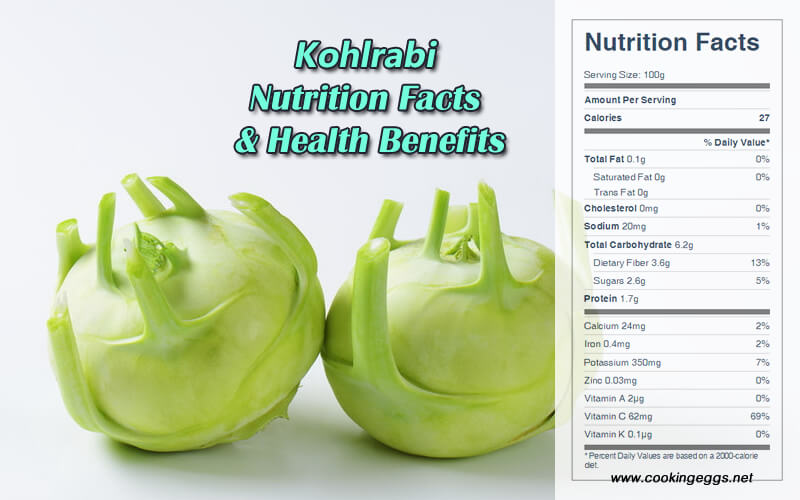Kohlrabi Nutrition Facts & Health Benefits
Kohlrabi also called German turnip, is an unusual looking vegetable. Kohlrabi is a member of the cabbage family, and although it's round like a turnip, it's not of the same species.
Kohlrabi is another cultivar of the same species as cabbage, broccoli, collard greens, cauliflower,Brussels sprouts, kale, and Savoy cabbage. The taste and texture of kohlrabi are similar to those of a broccoli stem or cabbage heart but milder and sweeter, with a higher ratio of flesh to skin. The young stem, in particular, can be as crisp and juicy as an apple, although much less sweet.

The nutritional value of kohlrabi
Raw kohlrabi is 91% water, 6% carbohydrates, 1% protein, and without fat. In a 100-gram reference serving, kohlrabi provides 27 kcal of food energy and is a rich source of vitamin C and vitamin B6, while also providing essential minerals like calcium, magnesium, phosphorous, and potassium.
A half-cup of kohlrabi provides 245 grams of potassium, 25 I.U. of vitamin A, 43.4 milligrams of vitamin C, 11.3 micrograms of folic acid, 16.8 mg of calcium, and about 10 mg of choline. It's a low-fat vegetable with only 19 calories in a half-cup serving that provides a healthy 23 mg of omega-3 fatty acids and 1.5 grams of protein.
Raw Kohlrabi Nutrition Facts Label
Health Benefits of Kohlrabi
Kohlrabi is a tasty vegetable that you can eat either raw or cooked. It's loaded with antioxidants, and it's a good source of fiber. As a remarkable source of vitamin C, kohlrabi helps your body absorb iron. Iron improves oxygen levels in red blood cells, which increases energy. Vitamin C helps protect cells from free radicals that can damage the body and cause disease.
Kohlrabi contains melatonin, which is an important hormone that does so much more than help us sleep. While we know melatonin is a hormone responsible for our circadian rhythms and our sleep–wake cycle, it also plays a significant role in the immune system.
Kohlrabi has health-promoting and anti-inflammatory benefits. Melatonin appears to function in two major pathways, namely the TH1 cell inhibition and the T regulatory cell induction, both of which favor an anti-inflammatory environment.
Melatonin also has anti-inflammatory properties, which are mediated by its inhibition of inflammatory cytokines as well as its effects on various immune system arms. Melatonin in the plant is part of the antioxidant defense system responsible for protecting the plant against free radicals.
A precursor to serotonin, our happy hormone, is also found in significant amounts in rutabaga and kohlrabi.
Individuals with thyroid disorders should make eating brassica vegetables a priority because of the effect they can have on thyroid hormone synthesis. Goitrin, to be specific, is an active goitrogen present in rutabaga, kohlrabi, and others.
Cuisine
The bulbous kohlrabi stem is frequently used raw in salads. It has a texture similar to that of a broccoli stem but with a flavor that is sweeter and less vegetal.
Kohlrabi leaves are edible and can be used similarly to collard greens and kale, but take longer to cook.
You can steam kohlrabi in a small amount of water, then lightly salt it to bring out its delicate flavor. Even the leaves can be steamed like spinach.
Diced or chopped kohlrabi makes a flavorful addition to any stir-fry. Lightly cooked, it will retain its crisp texture.